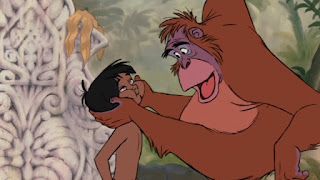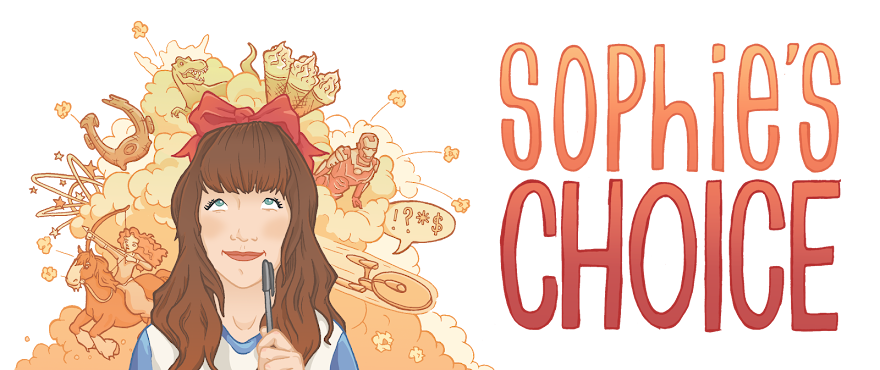The Jungle Book (1967)
 |
| When you're on mute in a Zoom call and completely switch off |
One of the main things I noticed that set The Jungle Book apart from its predecessor is the far superior pace of the storytelling. Perhaps this is due to having much more concrete source material in Rudyard Kipling's classic novel. After the charming panther, Bagheera sets the scene as narrator, telling us of Mowgli's early life with the wolves and how he has to be returned to his own kind, we're ready to get on with the journey.
 |
| Listening out for anyone still clapping for the NHS |
In quick succession, Mowgli is nearly caught and eaten by Kaa the snake, tries to join a herd of disorganised elephants, dances with a fun-loving bear, and gets hoodwinked by a gang of jazz-loving monkeys. While all of these scenes give the film a bopping beat, you do have to stop and think – Mowgli is a complete liability.
 |
| This signifies Mowgli's general self-awareness |
Firstly, he's infuriatingly naive and impressionable. Like the Indian version of Pinocchio, he simply follows and believes everyone he meets. Having known the sensible Bagheera all of his life, he constantly goes against his wishes to put himself in potential danger at every opportunity. Secondly, he's extremely precocious, constantly laughing at other animals' misfortunes and convinced that he could easily fight off the most deadly (and poshest) predator in the jungle, the tiger Shere Khan. The fact that he proves himself right is beside the point. LISTEN TO YOUR ELDERS, MOWGLI.
 |
| When you haven't cut your nails in quarantine yet |
Thirdly, he's the most fickle character ever. Having spent the entire film refusing to leave the jungle for any reason whatsoever, he claps eyes on one village girl a very on-the-nose, bordering on misogynistic song, thinks she looks pretty cute and just follows her to the man village after all. But boys will be boys, right?
While Mowgli is annoying in many ways, he does have an innocence that makes him somewhat endearing, and the challenges he presents to the ensemble cast is what creates the real magic. The relationship between Baloo and Bagheera is very well measured, with Bagheera's disdain thawing as the pair have to work together to take Mowgli to safety.
 |
| I want this pool float |
Baloo adds much-needed levity to the story, oozing a sense of cool ease as he swaggers around the jungle singing 'Bare Necessities.' Phil Harris' natural musicality and comic timing go on to win us over in the next two films on our list, which we'll explore later. His whole jam is completely copied again in Disney's '90s classic The Lion King, with Timon and Pumbaa's 'Hakuna Matata.' After some hard-eye rolling from Bagheera, you see his true colours when he weeps and offers and heartfelt, very generous eulogy to the bear when he thinks he's died protecting Mowgli. Baloo's reaction when he wakes up and wants to here more is comedy gold.
With a return to more polished, vibrant animation, an iconic soundtrack to get your toes-tapping, and a cast of cute, scary, and downright jazzy critters, it's no wonder The Jungle Book is a fan-favourite. It also cleverly speaks to its generation, with one foot in the familiar story and the other in the swinging '60s. Who can forget that vulture that sounds exactly like John Lennon? Classic.
 |
| Literally every day of lockdown |
Best Song: 'The Bare Necessities,' for being one of the catchiest tunes known to man (or bear). Interestingly, I've just found out that this is the only song in the film that wasn't written by the Sherman Brothers, but by the original, overthrown composer, Terry Gilkyson. Really, it has to win because I'm so sick of 'I Wan'na Be Like You' being covered by every swing band alive that is gets immediately disqualified from the competition. So there.
Disney Detail: Bambi's mum appears randomly again! Seriously, that doe gets around. Also, Kaa the snake is unmistakably the same voice as Winnie-the-Pooh which is creepy AF.
Why it's a Classic: It was THE Disney film of our parents' generation. With a male protagonist, it didn't alienate boys by being princessy. It combines adventure and humour with a legit soundtrack and gorgeously colourful animation, which never goes gaudy. It is telling that The Lion King, which is probably the most iconic Disney film among millennials, copies a lot of the same traits The Jungle Book. It's a winning formula.













